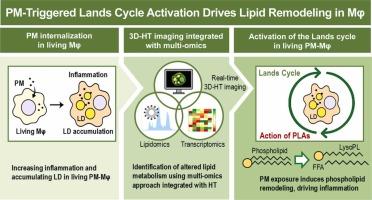陆地循环介导的巨噬细胞暴露于无标记颗粒物质中的炎症激活
IF 11.3
1区 环境科学与生态学
Q1 ENGINEERING, ENVIRONMENTAL
引用次数: 0
摘要
颗粒物(PM)是一种备受关注的污染物,对人类健康有着严重的影响。巨噬细胞(Mφ)在PM暴露的反应中起着至关重要的作用,因为它们经历与炎症相关的代谢重编程。然而,暴露于PM后,活体Mφ中发生的代谢变化尚不清楚。在这里,我们使用3d全息断层扫描(3D-HT)技术结合多组学分析,提供了PM激活Lands周期介导的炎症机制的证据。我们发现,内化PM会导致脂滴(LD)动力学异常,可能导致脂质代谢物水平的变化。此外,我们的多组学数据显示,Lands循环介导的脂质代谢改变导致炎症脂质介质的产生增加,包括溶血磷脂、神经酰胺和鞘磷脂。此外,通过对活体Mφ进行脂质代谢成像,我们阐明了脂质代谢活性的变化以及炎症与LD动力学之间的时空相关性。我们的研究结果表明,开发的方法可以为鉴定PM暴露后活细胞中的脂质代谢生物标志物提供新的实验策略。本文章由计算机程序翻译,如有差异,请以英文原文为准。

Activation of Lands Cycle-Mediated Inflammation in Living Macrophages Exposed to Label-Free Particulate Matter
Particulate matter (PM) is a pollutant of great concern and has severe impacts on human health. Macrophages (Mφ) play a crucial role in the response to PM exposure, as they undergo metabolic reprogramming associated with inflammation. However, upon exposure to PM, the metabolic changes that occur in living Mφ remain unclear. Here, we present evidence that PM activates Lands cycle-mediated inflammatory mechanisms using 3D-holotomography (3D-HT) technique integrated with multi-omics analysis. We show that internalization of PM results in abnormal lipid droplet (LD) dynamics, potentially leading to changes in lipid metabolite levels. Additionally, our multi-omics data reveal that alterations in lipid metabolism mediated by the Lands cycle leads to the increased production of inflammatory lipid mediators, including lysophospholipids, ceramides and sphingomyelin. Furthermore, by performing lipid metabolic imaging in living Mφ, we elucidated changes in the activity of altered lipid metabolism and the spatiotemporal correlation between inflammation and LD dynamics. Our findings suggest that the developed approach can provide a new experimental strategy to identify lipid metabolism biomarkers in living cells upon PM exposure.
求助全文
通过发布文献求助,成功后即可免费获取论文全文。
去求助
来源期刊

Journal of Hazardous Materials
工程技术-工程:环境
CiteScore
25.40
自引率
5.90%
发文量
3059
审稿时长
58 days
期刊介绍:
The Journal of Hazardous Materials serves as a global platform for promoting cutting-edge research in the field of Environmental Science and Engineering. Our publication features a wide range of articles, including full-length research papers, review articles, and perspectives, with the aim of enhancing our understanding of the dangers and risks associated with various materials concerning public health and the environment. It is important to note that the term "environmental contaminants" refers specifically to substances that pose hazardous effects through contamination, while excluding those that do not have such impacts on the environment or human health. Moreover, we emphasize the distinction between wastes and hazardous materials in order to provide further clarity on the scope of the journal. We have a keen interest in exploring specific compounds and microbial agents that have adverse effects on the environment.
 求助内容:
求助内容: 应助结果提醒方式:
应助结果提醒方式:


